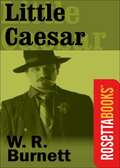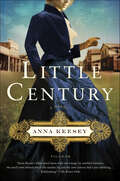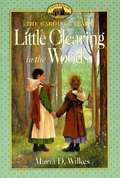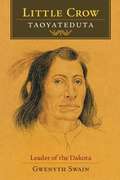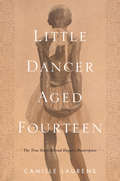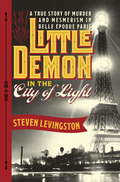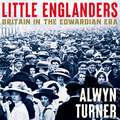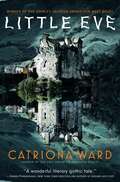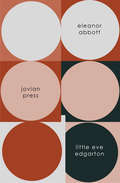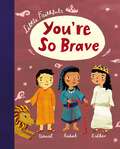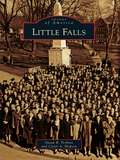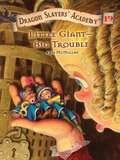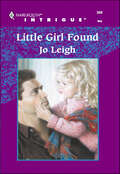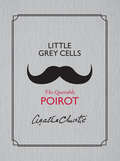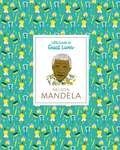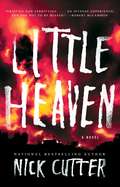- Table View
- List View
Little Britches: Father and I Were Ranchers
by Ralph MoodyRalph Moody was eight years old in 1906 when his family moved from New Hampshire to a Colorado ranch. Through his eyes we experience the pleasures and perils of ranching there early in the twentieth century. Auctions and roundups, family picnics, irrigation wars, tornadoes and wind storms give authentic color to Little Britches. So do adventures, wonderfully told, that equip Ralph to take his father's place when it becomes necessary. Little Britches was the literary debut of Ralph Moody, who wrote about the adventures of his family in eight glorious books, all available as Bison Books.
Little Brother: Love, Tragedy, and My Search for the Truth
by Ben WesthoffThis intimate exploration of race and inequality in America tells the story of a journalist&’s long-time relationship with his mentee, Jorell Cleveland, through the Big Brothers Big Sisters program and investigates Jorell's tragic fatal shooting. In 2005, soon after Ben Westhoff moved to St. Louis, he joined the Big Brothers Big Sisters program and was paired with Jorell Cleveland. Ben was twenty-eight, a white college grad from an affluent family. Jorell was eight, one of nine children from a poor, African American family living in nearby Ferguson. But the two instantly connected. Ben and Jorell formed a bond stronger than nearly any other in their lives. When Ben met the woman who'd become his wife, she observed that Ben and Jorell were "a package deal." They were brothers.In the summer of 2016, Jorell was shot at point blank range in broad daylight in the middle of the street, yet no one was charged in his death. Ben grappled with mourning Jorell, but also with a feeling of responsibility. As Jorell&’s mentor, what could he have done differently? As a journalist, he had reported on gang life, interviewed crime kingpins, and even infiltrated drug labs in China. But now, he was investigating the life and death of someone he knew personally and examining what he did and did not know about his friend. Learning the truth about Jorell and the man who killed him required Ben to uncover a heartbreaking cycle of poverty, poor education, drug trafficking, and violence. Little Brother brilliantly combines a deeply personal history with a true-crime narrative that exposes the realities of life in communities like Ferguson all around the country.
Little Brown Jug, The: The Michigan-Minnesota Football Rivalry (Images of Sports)
by Ken Magee Glenn E. Schembechler III Jon M. StevensWhen the Michigan Wolverines arrived in Minneapolis to battle the Minnesota Gophers in 1903, a simple 30¢, five-gallon Red Wing stoneware water jug began football's first rivalry trophy game. The "Little Brown Jug" has been the subject of conspiracy theories, theft, national championships, and most of all pride, with each game's victor prominently displaying the jug on its campus--until it is fought for again.
Little Caesar
by W. R. BurnettW.R. Burnett had first-hand experience of the world he describes in his vivid and terse novel Little Caesar (1929). The novel's hero, Cesare Bandello (Rico), is a "gutter Macbeth", a bad guy who claws his way through the ranks of a Chicago gang, circa 1928. Though the image of Rico is almost inseparable from Edward G. Robinson's star-making performance in the 1930 film version of the book, the novel, inspired in part by Machiavelli's The Prince, remains a fuller experience. It is believed to have had a profound effect on William Faulkner, Horace McCoy, and Graham Greene. There is nothing heroic about Rico. He is not a dashing or even especially talented man; the one gift he possesses is a laser-like focus. It is this intensity that sets him apart from the slovenly hoods that surround him. Rico is a cold, clear-eyed student of human nature. This knowledge initially provides Rico's success, but when it crystallizes into hubris, it results in his ultimate undoing. Rico becomes too satisfied with his success, forgetting that he has prevailed in what is essentially a jungle and that in this place, the laws of survival are immutable and unsparing. ABOUT THE AUTHOR William Riley Burnett (1899-1981) was a master of fiction, a skillful writer, contemporary to James M. Cain, Raymond Chandler, and Dashiell Hammett. Burnett authored some 36 novels and either wrote alone or in collaboration 60 screenplays. His novels Little Caesar, High Sierra, The Asphalt Jungle represent a rich vein of thought in contemporary American literature and culture. After he began his career as a writer, Burnett moved to Chicago in the late 1920s at the height of Al Capone's power and sway over the city. It was this atmosphere, Chicago in the '20s and notably the St. Valentine's Day Massacre (Burnett was one of the first people on the scene) that inspired Burnett's first great success Little Caesar, which was made into a film by the same name starring Edward G. Robinson. After this initial success, Burnett had a strong, close working relationship with Hollywood as both a novelist and screenwriter, and eventually found a champion in writer/director John Huston. Burnett collaborated with Huston on the adaptation of High Sierra in 1941 in which Humphrey Bogart redefined himself in the role of Roy Earle. The two men's paths crossed again when Huston filmed The Asphalt Jungle in 1950. The Mystery Writers of America awarded Burnett their highest honor--the prestigious title of Grand Master--at the 1980 Edgar Awards. SERIES DESCRIPTIONS From classic book to classic film, RosettaBooks has gathered some of most memorable books into film available. The selection is broad ranging and far reaching, with books from classic genre to cult classic to science fiction and horror and a blend of the two creating whole new genres like Richard Matheson's The Shrinking Man. Classic works from Vonnegut, one of the greatest writers of the twentieth century, meet with E.M. Forster's A Passage to India. Whether the work is centered in the here and now, in the past, or in some distant and almost unimaginable future, each work is lasting and memorable and award-winning.
Little Century: A Novel
by Anna KeeseyIn the tradition of such classics as My Ántonia and There Will Be Blood, Anna Keesey's Little Century is a resonant and moving debut novel by a writer of confident gifts.Orphaned after the death of her mother, eighteen-year-old Esther Chambers heads west in search of her only living relative. In the lawless frontier town of Century, Oregon, she's met by her distant cousin, a laconic cattle rancher named Ferris Pickett. Pick leads her to a tiny cabin by a small lake called Half-a-Mind, and there she begins her new life as a homesteader. If she can hold out for five years, the land will join Pick's already impressive spread.But Esther discovers that this town on the edge of civilization is in the midst of a range war. There's plenty of land, but somehow it is not enough for the ranchers—it's cattle against sheep, with water at a premium. In this charged climate, small incidents of violence swiftly escalate, and Esther finds her sympathies divided between her cousin and a sheepherder named Ben Cruff, a sworn enemy of the cattle ranchers. As her feelings for Ben and for her land grow, she begins to see she can't be loyal to both.Little Century maps our country's cutthroat legacy of dispossession and greed, even as it celebrates the ecstatic visions of what America could become.
Little Clearing in the Woods
by Maria D. WilkesYoung Caroline Quiner, who would grow up to be Laura Ingalls Wilder's mother, and her family move to a new farm near Concord, Wisconsin.
Little Crow Taoyateduta: Leader of the Dakota
by Gwenyth SwainThe Plains Indian Wars of the nineteenth century garnered enduring fame for certain Indian leaders, their names echoing powerfully even today: Sitting Bull, Crazy Horse, Red Cloud. Just as significant but less often mentioned is Taoyateduta, known to whites as Little Crow, the reluctant leader of Dakota warriors during the U. S. -Dakota War of 1862, the opening salvo of the U. S. -Indian Wars. In this carefully researched biography of the Dakota leader, the first ever written for children, author Gwenyth Swain presents a compelling portrait of the leader, warrior, and politician at the center of the Dakota War of 1862. Beginning with Taoyateduta's childhood along the Mississippi River near present-day St. Paul, this biography explores his life in the Big Woods, his wanderings west from the Mdewakanton Dakota's traditional home, his leadership of his people when they were forced to sign over their land to white settlers, and his role during the war of 1862. Hemmed in on a narrow reservation, frustrated by broken treaties, angered by dishonest agents and traders, and nearly starved because of crop failures and late annuity payments, Dakota Indians attacked white settlers living on the Indians' former homelands in southwestern Minnesota. Taoyateduta agreed to lead the battles, knowing that the U. S. government's response would be swift and terrible. In retribution for the thirty-eight-day war, thirty-eight Dakota men were hanged, thousands were imprisoned, and the Dakota people were expelled from the state. Taoyateduta's story brings to life the painful experience of the Dakota as they lost their land and their livelihood--and as some chose to adopt white ways while others fought back, with disastrous consequences. Little Crow: Leader of the Dakota offers a clear and accessible account of both the man who led the Dakota into war and the causes behind that wrenching conflict.
Little Dancer Aged Fourteen: The True Story Behind Degas's Masterpiece
by Camille LaurensThis absorbing, heartfelt work uncovers the story of the real dancer behind Degas’s now-iconic sculpture, shedding light on the struggles of late nineteenth-century Parisian life. She is famous throughout the world, but how many know her name? You can admire her figure in Washington, Paris, London, New York, Dresden, or Copenhagen, but where is her grave? We know only her age, fourteen, and the work that she did—because it was already grueling work, at an age when children today are sent to school. In the 1880s, she danced as a “little rat” at the Paris Opera, and what is often a dream for young girls now wasn’t a dream for her. She was fired after several years of intense labor; the director had had enough of her repeated absences. She had been working another job, even two, because the few pennies the Opera paid weren’t enough to keep her and her family fed. She was a model, posing for painters or sculptors—among them Edgar Degas. Drawing on a wealth of historical material as well as her own love of ballet and personal experiences of loss, Camille Laurens presents a compelling, compassionate portrait of Marie van Goethem and the world she inhabited that shows the importance of those who have traditionally been overlooked in the study of art.
Little Demon in the City of Light
by Steven LevingstonA delicious account of a murder most gallic--think CSI Paris meets Georges Simenon--whose lurid comibation of sex, brutality, forensics, and hypnotism riveted first a nation and then the world.Little Demon in the City of Light is the thrilling--and so wonderfully French--story of a gruesome 1889 murder of a lascivious court official at the hands of a ruthless con man and his pliant mistress and the international manhunt, sensational trial, and an inquiry into the limits of hypnotic power that ensued.In France at the end of the nineteenth century a great debate raged over the question of whether someone could be hypnotically compelled to commit a crime in violation of his or her moral convictions. When Toussaint-Augustin Gouffé entered 3, rue Tronson du Coudray, he expected nothing but a delightful assignation with the comely young Gabrielle Bompard. Instead, he was murdered--hanged!--by her and her companion Michel Eyraud. The body was then stuffed in a trunk and dumped on a riverbank near Lyon.As the inquiry into the guilt or innocence of the woman the French tabloids dubbed the "Little Demon" escalated, the most respected minds in France debated whether Gabrielle Bompard was the pawn of her mesmerizing lover or simply a coldly calculating murderess. And, at the burning center of it all: Could hypnosis force people to commit crimes against their will?
Little Dreamers: Visionary Women Around the World (Vashti Harrison)
by Vashti HarrisonFrom the New York Times bestselling author of Little Leaders: Bold Women in Black History comes the highly anticipated follow-up, a beautifully illustrated collectible detailing the lives of women creators around the world.Featuring the true stories of 40 women creators, ranging from writers to inventors, artists to scientists, Little Dreamers: Visionary Women Around the World inspires as it educates. Readers will meet trailblazing women like Mary Blair, an American modernist painter who had a major influence on how color was used in early animated films, actor/inventor Hedy Lamar, environmental activist Wangari Maathai, architect Zaha Hadid, filmmaker Maya Deren, and physicist Chien-Shiung Wu. Some names are known, some are not, but all of the women had a lasting effect on the fields they worked in.The charming, information-filled full-color spreads show the Dreamers as both accessible and aspirational so reader knows they, too, can grow up to do something amazing.
Little Englanders: Britain in the Edwardian Era
by Alwyn TurnerA queen's death and a king's coronation. Rising mass media and declining public morals. Splits in all the major political parties and a new wave of social activism. War abroad and strikes at home. Welcome to Edwardian England.When Queen Victoria died in 1901 it was the end of an era. Britain's dominance stretched across seven continents and its ruling classes were wealthier than ever before. Many later remembered the decade or so that followed as the long afternoon of an empire where the sun never set. Yet the Edwardians themselves were acutely aware that the country was in a state of flux; the seismic change that they felt would transform modern Britain forever.In Little Englanders, Alwyn Turner reconsiders the Edwardian era as a time of profound social change, with the rise of women's suffrage and the labour movement, unrest in Ireland and the Boer republics, scandals in parliament and culture wars at home. He tells the story of the Edwardians through music halls and male beauty contests, the real Peaky Blinders and the 1908 Summer Olympics, and Marie Lloyd, Arthur Conan Doyle and Winston Churchill. In this colourful, detailed and hugely entertaining social history, Turner shows that, though the golden Victorian age was in the past, the birth of modern Britain was only just beginning.
Little Eve
by Catriona WardWinner of the Shirley Jackson Award for Best Novel • Winner of the British Fantasy Award for Best Horror Novel • A LibraryReads Hall of Fame Pick!From Catriona Ward, author of The Last House on Needless Street, comes a heart-pounding tale of faith and family, with a devastating twist“A great day is upon us. He is coming. The world will be washed away.”On the wind-battered isle of Altnaharra, off the wildest coast of Scotland, a clan prepares to bring about the end of the world and its imminent rebirth.The Adder is coming and one of their number will inherit its powers. They all want the honor, but young Eve is willing to do anything for the distinction.A reckoning beyond Eve’s imagination begins when Chief Inspector Black arrives to investigate a brutal murder and their sacred ceremony goes terribly wrong.And soon all the secrets of Altnaharra will be uncovered.At the Publisher's request, this title is being sold without Digital Rights Management Software (DRM) applied.
Little Eve Edgarton
by Eleanor AbbottBut you live like such a fool—of course you're bored! drawled the Older Man, rummaging listlessly through his pockets for the ever-elusive match…
Little Faithfuls: You're So Brave (Little Faithfuls)
by Carrie MarrsChildren will be inspired to be brave for God as they read this biography collection of Bible heroes who took action and did courageous things with God&’s help.Little Faithfuls is the first Christian series of &”Little&” biography collections for kids. Fans of the Little People, Big Dreams series, Who Was? series, and This Little Trailblazer and This Little Dreamer will love introducing their children to the best role models of all, straight out of Scripture.This beautiful picture book for 4 to 8-year-oldstells God&’s big story of bravery, from David fighting Goliath, Esther risking her life to save her people, and Mary believing the angel's announcement that she would be the mother of Jesusfeatures 12 godly men and women from your favorite Bible stories in the Old and New Testamentsreminds young readers what it means to be brave, why bravery is an exciting opportunity from God, and how they can be a brave part of God's story tooteaches that God helps people be brave and uses them for good in the worldempowers kids to take action and do the right thing even when it&’s scaryWith eye-catching art and age-appropriate biographical bonus facts, You're So Brave focuses on God's big story of bravery, culminating in Jesus' ultimate bravery on the cross. Children will learn that God's people were brave because they loved following God. As it points young readers back to the true source of their bravery, this inspiring picture book draws kids in to learn more about heroes of faith and to be brave right where they are.
Little Faithfuls: You're So Kind (Little Faithfuls)
by Carrie MarrsChildren will be inspired to be kind for God as they read this biography collection of Bible heroes who took action and showed kindness with God&’s help.Little Faithfuls is the first Christian series of &”Little&” biography collections for kids. Fans of the Little People, Big Dreams series, Who Was? series, and This Little Trailblazer and This Little Dreamer will love introducing their children to the best role models of all, straight out of Scripture.This beautiful picture book for 4 to 8-year-oldstells God&’s big story of kindness, from Joseph forgiving his brothers, Ruth choosing to go with Naomi to a new place, and Tabitha providing food and clothes for people in needfeatures 12 godly men and women from your favorite Bible stories in the Old and New Testamentsreminds young readers what it means to be kind, why kindness is an exciting opportunity from God, and how they can be a part of God's story by showing kindnessteaches that being kind shows others how much God loves themempowers kids to take action and do the right thing even when it&’s scaryWith eye-catching art and age-appropriate biographical bonus facts, You're So Kind focuses on God's big story of kindness, culminating in Jesus' ultimate kindness on the cross. Children will learn that God's people were kind because God first showed kindness to His people. As it points young readers back to the true source of kindness, this inspiring picture book draws kids in to learn more about heroes of faith and to be kind right where they are.
Little Falls
by Caryl A. Hopson Susan R. PerkinsNestled in a deep gorge along the Mohawk River, Little Falls first came into being as a village in 1811 and became Herkimer County's only city in 1895. With its close proximity to main routes of transportation via the Erie Canal system and railroad, as well as its access to waterpower from the Mohawk River, Little Falls became a manufacturing leader and Herkimer County's largest populated area. It was famous nationwide for its cheese market and innovations in dairy and cheese manufacturing equipment. It was the site of one of the worst train wrecks in the history of the New York Central Railroad, boasts the sixth-highest lift lock in the world, and is the hometown of a famous radio personality who started the televised dance show Twist-A-Rama in the 1960s.
Little Giant--Big Trouble #19
by Kate McmullanSomething BIG is going on in the woods near DSA! Wiglaf and his friends are on a rescue mission to save Worm, the dragon they’ve raised since he hatched. They thought that a gang of knightsin- training was the problem, but it turns out that it’s a little girl GIANT! The DSA kids can’t let Worm become her house pet. But how can they free him? .
Little Girl Found (Lovers Under Cover)
by Jo LeighStrong, silent typeWhen a child was dropped on ex-detective Jac McCabe's doorstep, he voxed to guard her with his life. She had no one to claim her-except sexy caregiver Hailey Bishop. And both vulnerable ladies needed his protection from killers tying up loose ends-killers who might be dirty cops...In need of healing...Jack worried he wasn't the right man for this job-not since the accident that had stripped him of his badge, his life. But together they formed a fugitive family, working to keep one another safe...and Jack felt whole for the first time in years. Maybe he was the one who'd been found and rescued after all.
Little Girl Lost: A gripping and emotional historical novel from the Sunday Times bestseller
by Val WoodMargriet grew up as a lonely child in the old town of Hull. Her adored father often travelled by sea to the Netherlands, leaving her with an unaffectionate mother and only her imagination of a little Dutch girl, Anneliese, to keep her company. When devastation ravages her tiny family. Annelise becomes the comforting friend Margriet needs for a long time to come.A few years later, Margriet is blossoming into a kind young lady. Keen to escape her mother and strike out on her own, she forms an unlikely friendship with some of the street children who roam the town.As Margriet acts upon her inspiration to help them, will the troubles of her past break her spirit, or will she be able to overcome them?If you've liked books by Katie Flynn and Dilly Court, you'll love Val's heart-rending stories of triumph over adversity.
Little Green: Growing Up During the Chinese Cultural Revolution
by Chun YuI was born in a small city near the East Sea,when the Great Cultural Revolution began.My name is Little Green,my country Zhong Guo, the Middle Kingdom. When I was ten years old,our leader had died and the revolution ended. And this is how I remember it. When Chun Yu was born in a small city in China, she was born into a country in revolution. The streets were filled with roaming Red Guards, the walls were covered with slogans, and reeducation meetings were held in all workplaces. Every family faced danger and humiliation, even the youngest children. Shortly after Chun’s birth, her beloved father was sent to a peasant village in the countryside to be reeducated in the ways of Chairman Mao. Chun and her brother stayed behind with their mother, who taught in a country middle school where Mao’s Little Red Book was a part of every child’s education. Chun Yu’s young life was witness to a country in turmoil, struggle, and revolution—the only life she knew. This first-person memoir of a child’s view of the Chinese Cultural Revolution is a stunning account of a country in crisis and a testimony to the spirit of the individual—no matter how young or how innocent.
Little Grey Cells: The Quotable Poirot (Apple FF)
by Agatha Christie"My name is Hercule Poirot and I am probably the greatest detective in the world."The dapper,moustache-twirling little Belgian with the egg-shaped head, curious mannerisms and inordinate respect for his own ‘little grey cells’ solved some of the twentieth century’s most puzzling crimes. But what do we really know about the eccentric genius underneath that fussy façade?Sometimes funny, often profound, and always revealing, this book of quotes and comments from more than fifty Poirot novels and short stories gives an entertaining glimpse of the man behind the moustache, and the wit and wisdom of the Queen of Crime who created him.Includes an exclusive essay by Agatha Christie on her love/hate relationship with her most famous creation.
Little Guides To Great Lives: Nelson Mandela
by Isabel ThomasAnti-apartheid revolutionary, politician, and philanthropist, Nelson Mandela's journey from political prisoner to president of South Africa is an incredible tale of triumph in the face of adversity. 2018 marks a hundred years since his birth. From artists to aviators and scientists to revolutionaries, Little Guides to Great Lives is a brand new series of small-format guides introducing children to the most inspirational figures from history in a fun, accessible way.
Little Heathens: Hard Times and High Spirits on an Iowa Farm During the Great Depression
by Mildred Armstrong KalishI tell of a time, a place, and a way of life long gone. For many years I have had the urge to describe that treasure trove, lest it vanish forever. So, partly in response to the basic human instinct to share feelings and experiences, and partly for the sheer joy and excitement of it all, I report on my early life. It was quite a romp.<P><P> So begins Mildred Kalish's story of growing up on her grandparents' Iowa farm during the depths of the Great Depression. With her father banished from the household for mysterious transgressions, five-year-old Mildred and her family could easily have been overwhelmed by the challenge of simply trying to survive. This, however, is not a tale of suffering.<P> Kalish counts herself among the lucky of that era. She had caring grandparents who possessed--and valiantly tried to impose--all the pioneer virtues of their forebears, teachers who inspired and befriended her, and a barnyard full of animals ready to be tamed and loved. She and her siblings and their cousins from the farm across the way played as hard as they worked, running barefoot through the fields, as free and wild as they dared.<P> Filled with recipes and how-tos for everything from catching and skinning a rabbit to preparing homemade skin and hair beautifiers, apple cream pie, and the world's best head cheese (start by scrubbing the head of the pig until it is pink and clean), Little Heathens portrays a world of hardship and hard work tempered by simple rewards. There was the unsurpassed flavor of tender new dandelion greens harvested as soon as the snow melted; the taste of crystal clear marble-sized balls of honey robbed from a bumblebee nest; the sweet smell from the body of a lamb sleeping on sun-warmed grass; and the magical quality of oat shocking under the light of a full harvest moon.<P> Little Heathens offers a loving but realistic portrait of a "hearty-handshake Methodist" family that gave its members a remarkable legacy of kinship, kindness, and remembered pleasures. Recounted in a luminous narrative filled with tenderness and humor, Kalish's memoir of her childhood shows how the right stuff can make even the bleakest of times seem like "quite a romp."
Little Heaven: A Novel
by Nick CutterA “gripping and terrifying story…and one not to be missed” (Robert McCammon) from the acclaimed author of The Troop and The Deep!A trio of mismatched mercenaries—Micah Shughrue, Minerva Atwater, and Ebenzer Elkins, colloquially known as “the Englishman”—is hired by young Ellen Bellhaven for a deceptively simple task: check in on her nephew, who may have been taken against his will to a remote New Mexico backwoods settlement called Little Heaven, where a clandestine religious cult holds sway. But shortly after they arrive, things begin to turn ominous. There are stirrings in the woods and over the treetops—and above all else, the brooding shape of a monolith known as the Black Rock casts its terrible pall. Paranoia and distrust soon grip the settlement. Escape routes are gradually cut off as events spiral toward madness. Hell—or the closest thing to it—invades Little Heaven. All present here are now forced to take a stand and fight back, but whatever has cast its dark eye on Little Heaven is marshaling its power—and it wants them all… “A slow boil of unrelenting terror and inescapable consequences. Nick Cutter ups his game every time. Beautifully written—menace drips from every page.” —Seanan McGuire, New York Times bestselling author “A sprawling epic that can stand alongside the best of ‘80s King, Barker, and McCammon. Fun, nasty, smart, and scary, and in all the right places.” —Paul Tremblay, acclaimed author of A Head Full of Ghosts and Disappearance at Devil’s Rock



